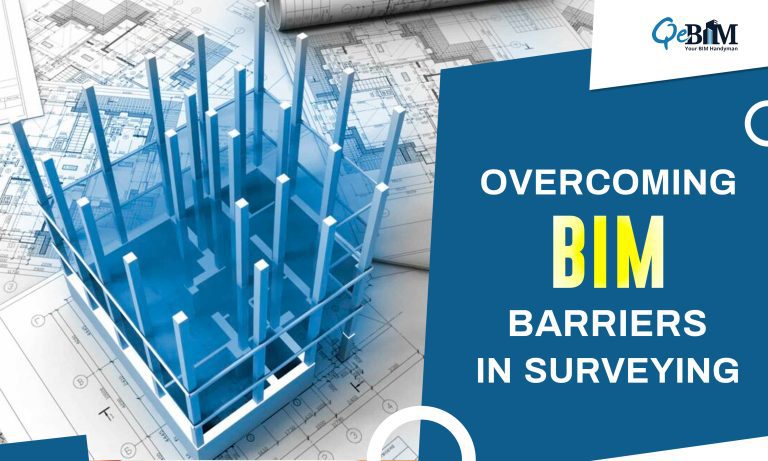Overcoming BIM Barriers in Surveying

Introduction
Building Information Modelling (BIM) is emerging as a disruptive tool in surveying, and revolutionizing how infrastructure projects are conceived, built, and maintained. BIM Modeling Services help surveyors to increase cooperation, effectiveness, as well as cost-cutting by combining computerized representations of both physical and operational elements of a project. This strong instrument, nevertheless, is not without its drawbacks. In this blog, we are going to examine the potential and problems that BIM presents to surveyors, emphasizing the importance of BIM for building infrastructure and offering facts including statistical data.
Opportunities of BIM for Surveyors
- Enhanced Collaboration: BIM promotes flawless collaboration among stakeholders such as architects, engineers, contractors, as well as surveyors. Surveyors may communicate precise information and insights via the common platform, eliminating mistakes and boosting collaboration on projects.
- Improved Design and Visualization: BIM modelling services empower surveyors to build detailed 3D models that give a full perspective of the construction project. These models provide greater visualization and analysis, allowing surveyors to discover possible conflicts or concerns prior to the start of construction.
- Project Management Simplified: BIM allows surveyors to combine project information, such as survey responses, timetables, and expenses, onto one platform. This connection improves project management by allowing for more informed decision-making and lowering the probability of complications and expense overruns.
- Increased Value: BIM might help to survey services to be more valuable. BIM might assist surveyors offer enhanced results for customers by offering an increasingly precise, effective, as well as innovative way of working. This might result in higher profitability plus a share of the market for surveyors that use BIM.
- Efficient Asset Management: BIMs brimming with models offer surveyors an amazing asset management tool. Surveyors might track building performance, schedule preventative maintenance, and optimize asset management throughout their lifecycle by using real-time data that includes maintenance logs as well as sensor information.
- Time and expense savings: By discovering incompatibilities and discrepancies at the beginning of the design process, BIM lowers reworking and mistakes. According to a National Institute of Building Sciences research, BIM may cut rework expenses by up to 52% and the duration of construction by up to 7%.
Challenges of BIM for Surveyors
- Adoption and Training: Robust adoption of BIM modeling services necessitates the acquisition of novel abilities and expertise by surveyors. Training programmes as well as a culture shift inside organisations are required to guarantee competent surveyors may employ BIM tools and procedures efficiently.
- Data Standardisation: In order to guarantee seamless integration and data transmission amongst multiple software platforms, BIM leverages standardized data formats as well as protocols. Setting and sustaining such requirements may be difficult, particularly in big construction projects with diverse stakeholders.
- Issues of Law and Contract: BIM presents fresh legal as well as contractual concerns. Intellectual property rights, and responsibility, including ownership of BIM models, are just a few topics that necessitate thoughtful deliberation and unambiguous agreements amongst project participants.
- Data Security and Privacy: BIM creates a large volume involving delicate project information, prompting issues regarding data security as well as privacy. It is critical to protect sensitive data through unauthorized manipulation or harmful activity, which necessitates strong cybersecurity measures.
- Collaboration and Coordination: Although BIM encourages cooperation, its effectiveness is dependent on excellent liaison and collaboration between parties. Combating silos, synchronizing goals, and setting up straightforward processes are critical for surveyors to maximize the potential advantages of BIM.
- Skills Gap: Another issue with BIM is a scarcity of experienced surveyors who can utilize it. The appetite for BIM-certified surveyors is increasing, while supply has been unable to keep up. This presents a significant impediment to BIM adoption within the surveying business.
- Standardization: There additionally exists an absence of standardization in the application of BIM. Surveyors may find it challenging to exchange data using the remainder such as the building team as a result of this. Furthermore, the absence of standards might make integrating BIM using other software systems challenging.
Conclusion
The introduction of BIM for Infrastructure possesses greatly revolutionized the building surveying industry, opening up enormous prospects for enhanced communication, design visualization, project management, managing assets, as well as expense reductions. Surveyors may help foster a more sustainable and effective building of infrastructure by using the potential of BIM.
In order effectively realize the promise of BIM, nevertheless, obstacles relating to adoption, data standardization, legal concerns, data security, and cooperation require being solved. While the building sector embraces BIM, surveyors must modify their abilities and methods in order to accept new technology and realize its huge potential for the foreseeable future of building infrastructure.